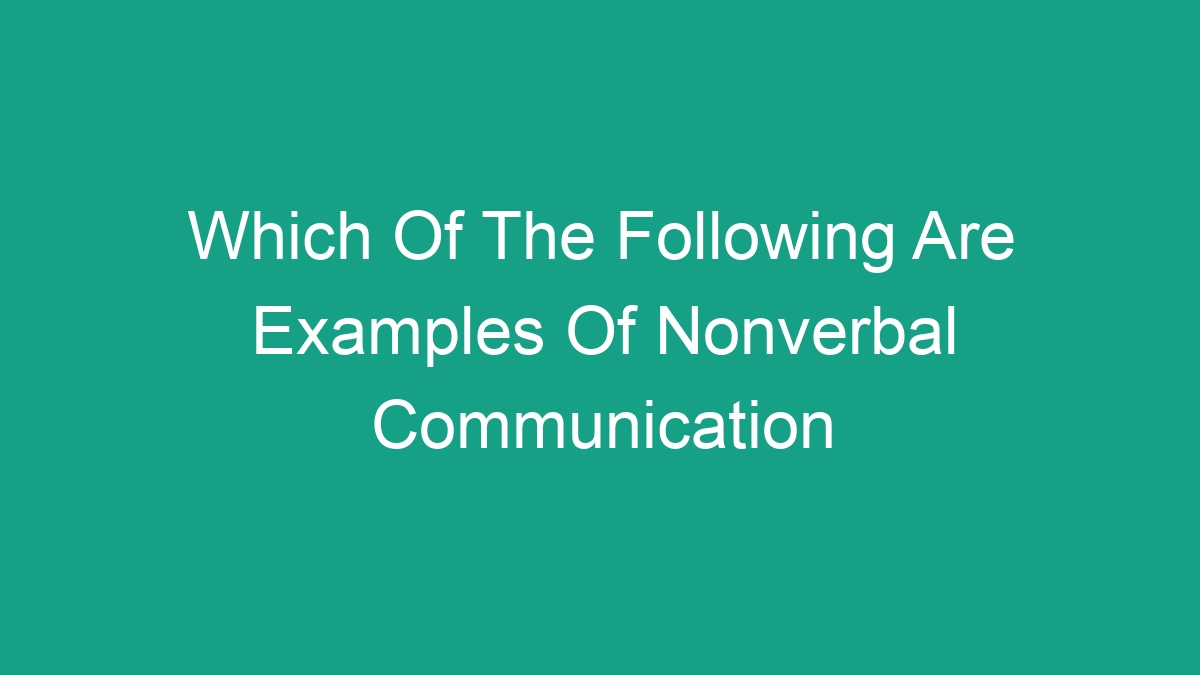
Nonverbal communication plays an essential role in our daily interactions. The way we gesture, use body language, and even our facial expressions can convey powerful messages without saying a word. In this article, we will explore the various examples of nonverbal communication and how they impact our everyday lives.
Understanding Nonverbal Communication
Nonverbal communication refers to the transmission of messages or signals through nonverbal cues such as body language, facial expressions, gestures, and vocalics. These cues can complement, emphasize, regulate, or contradict the verbal message being communicated. Nonverbal communication is essential in understanding the emotions, attitudes, and intentions of others.
Body Language: Body language includes a range of nonverbal signals conveyed through body movements and postures. This can include gestures, facial expressions, eye contact, and overall body movements. For example, crossing one’s arms can signal defensiveness or resistance, while maintaining eye contact can convey confidence and engagement.
Facial Expressions: Facial expressions play a crucial role in nonverbal communication. Smiling, frowning, or raising eyebrows can convey a wide range of emotions such as happiness, sadness, surprise, or anger. These expressions are universally recognized and can impact how a message is received.
Gestures: Gestures are nonverbal movements that accompany speech and are used to emphasize or illustrate a point. Common gestures include nodding to indicate agreement, shaking the head to signal disagreement, or pointing to draw attention to something.
Vocalics: Also known as paralanguage, vocalics refers to the nonverbal elements of speech such as tone, pitch, volume, and speed. These vocal cues can convey emotions and attitudes, impacting the overall message being communicated.
Examples of Nonverbal Communication
1. Proxemics: Proxemics refers to the use of personal space to convey a message. For example, standing close to someone can indicate intimacy or dominance, while maintaining a distance can signal respect or discomfort.
2. Haptics: Haptics refers to the use of touch in communication. A firm handshake can convey confidence and trust, while a soft touch can signal comfort or sympathy.
3. Chronemics: Chronemics refers to the use of time in communication. For example, arriving early for a meeting can signal respect, while being late can convey disrespect or lack of consideration.
4. Olfactics: Olfactics refers to the use of scent in communication. Certain scents can evoke specific emotions or memories, impacting the overall communication process.
5. Clothing and Appearance: One’s clothing and appearance can convey a message about their personality, status, or cultural affiliation. For example, formal attire can signal professionalism, while casual clothing can signal a relaxed or informal environment.
The Importance of Nonverbal Communication
Nonverbal communication plays a crucial role in our interactions, often conveying more information than verbal communication alone. It can impact how a message is received, influence interpersonal relationships, and even affect business negotiations.
Enhanced Understanding: Nonverbal cues can provide additional context to verbal messages, helping to enhance understanding and clarity in communication.
Emotional Expression: Nonverbal communication allows individuals to express and interpret emotions, creating a deeper connection and understanding between people.
Relationship Building: Nonverbal cues play a significant role in building and maintaining relationships. Positive nonverbal cues such as eye contact, smiling, and open body language can foster trust and rapport.
Impact on Impression: Nonverbal communication contributes to the formation of first impressions. A firm handshake, confident posture, and genuine smile can leave a positive impact on others.
Conclusion
Nonverbal communication is a powerful tool that influences our everyday interactions. It encompasses a wide range of cues including body language, facial expressions, gestures, vocalics, and other sensory elements. Understanding and utilizing nonverbal communication can enhance our ability to connect with others, convey messages effectively, and build strong interpersonal relationships. By being mindful of nonverbal cues, we can become more effective communicators and better understand the subtle messages being conveyed in our daily interactions.



